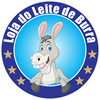Consumo de leite de burro e benefícios para a saúde humana, com referência especial ao estado inflamatório.
Muitas vezes confundido como alergia á lactose aproximadamente 7% da nossa população é alérgica á proteína do leite de vaca.
Donkey Milk contains numerous nutrients. The content of n-3 fatty acids, the n-6/n-3 ratio, and short- and medium-chain fatty acids may promote positive health effects.
Milk is a source of bioactive compounds essential for the health and growth of newborns. Donkey milk, rich in lactose and whey proteins, has been proven to be a good breast milk substitute during infancy and adequate nourishment for patients with cow milk protein allergy.
A progressive decline of immune functions with age and both innate and adaptive immune responses are severely impaired and increase the susceptibility of old people to infections, tumors, and autoimmune diseases.
The legendary cosmetic and therapeutic properties of equine milk are widely known. In fact, Cleopatra, Poppea and other privileged women of ancient times took their baths in donkey’s milk in order to keep their skin fresh and shiny. In addition, Hippocrates, as well as Pliny the Elder, believed that donkey’s milk could act therapeutically in numerous cases, such as liver problems, infectious diseases, fevers, asthma, etc. (Cunsolo et al., 2011).
The antimicrobial activity of donkey milk was examined against 3 bacterial and 3 fungal strains selected on the basis of their relevance as human pathogens. All samples of donkey milk exhibited antimicrobial activity against dermatomycotic fungi and foodborne pathogen bacteria.
Human breast milk is the best nutritional support that ensures the right development and influences the immune status of the newborn infant. .
Donkey’s milk is the best substitute of human milk for its content in lactose, proteins, minerals, and
The diversity of lactic acid bacteria (LAB) species in donkey’s milk was analyzed by culture-dependent microbial techniques. Dominant strains were isolated on agar media generally used for enumerating LAB. To enrich the number of acidifying LAB present, the milk samples were incubated at 37°C for 24 h (cultured milk samples, CM).
Fortification of human milk is standard practice for feeding very low birth weight infants. However, preterm infants often still experience suboptimal growth and feeding intolerance.
Allergy to cow’s milk proteins is one of the most common food allergies in children, and it is estimated that it affects 2 to 5% of the child population under 3 years of age (Huang and Kim, 2012). Symptoms, that can manifest immediately or within a few hours of consumption, can be cutaneous (itching, hives), gastrointestinal (abdominal pains, diarrhea), respiratory (asthma) or even systemic (anaphylaxis).
Different nutritional components are able, by modulating mitochondrial function and gut microbiota composition, to influence body composition, metabolic homeostasis and inflammatory state. In this study, we aimed to evaluate the effects produced by the supplementation of different milks
Different nutritional components are able, by modulating mitochondrial function and gut microbiota composition, to influence body composition, metabolic homeostasis and inflammatory state. In this study, we aimed to evaluate the effects produced by the supplementation of different milks
Donkey’s milk could be considered suitable for feeding young children affected by
severe IgE-mediated CMPA because its nutritional properties and composition are very close to
human milk.
Donkey milk is also considered useful in the prevention of atherosclerosis and has the ability to upregulate the immune response of healthy elderly humans.
Milk is one of the most common causes of food allergies among children under one year of age. No specific therapy exists for this allergy, and thus the only feasible response is to avoid the assumption of milk and derived products
Cow’s milk protein allergy affects 2-7% of children using cow’s milk formulae. Fifty to eighty percent of them develop allergy to other food items and substitutes. Donkey milk, in contrast, is the closest to breast milk
Donkey milk yield and chemical composition were investigated in two lactations
Several studies have recently enlightened therapeutic use of ass’ milk (AM) due to its special composition and nutritional properties, which are very close to a human one.
In children with Cow Milk Protein Allergy (CMPA), when it is not possible to breastfeed or to use cow milk, the clinical use of donkey milk is considered since several studies have demonstrated the high similarity of donkey milk compared to human milk.
Donkey's and goat's milk consumption has been reevaluated for its potential benefits to human health.
Lactobacillus rhamnosus results evidenced that ass’s milk is indeed an excellent candidate for probiotic beverages.
